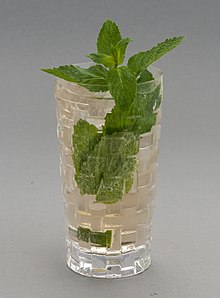Mojito
The mojito [ moˈxiːto ] is a cocktail made from light Cuban rum , lime juice , mint , cane sugar and soda water . It is one of the most famous mixed drinks. Due to its volume, the mojito can be counted as a long drink .
history
The mojito is originally a Cuban drink, but there are various explanations about the origin of its name. According to one, the name should be derived from the West African word mojo , a cloth bag with magical spices and magic objects - as a diminutive (belittling) form of this loan word , mojito would therefore mean "little magic". There is also a spice mix of the same name, from which the name could be derived, but this mojo is actually prepared with bitter oranges , not limes. The word could also be derived from the Spanish mojar (to make wet) and represent a shortening of the adjective mojadito (a little wet) or mojado (wet).
The mojito goes back to a long tradition of rum drinks in the Caribbean . As early as the 16th century, the British privateer Francis Drake is said to have consumed a drink made from sugar, real limes (a sour, aromatic Caribbean variety), aguardiente de Caña (a simple sugar cane schnapps) and mint for his stomach problems. Drake was feared by the Spaniards and was nicknamed "El Draque" (Spanish for the dragon), which is also the name given to the drink that was later mixed with rum when its production spread throughout the Caribbean. The Cuban author Rámon de Palma wrote in his story El Cólera en Habana in 1838 : "Every day at eleven o'clock I take a Draquecito, and that is very good for me."
This mixture was only called mojito at the beginning of the 20th century: According to the author Ciro Bianchi Ross and the Cuban historian Miguel Bonera, the mojito first appeared in print in 1910 and was served in La Concha in Havana . At the time, iced drinks were extremely popular, and ice had long been made commercially. The mojito finally became a legend thanks to Ernest Hemingway , who ordered it from Angel Martinez in his regular bar La Bodeguita del Medio in Havana. One of his sayings hangs over the counter there today: "My Mojito in La Bodeguita, my Daiquiri in El Floridita" ("My Mojito in the Bodeguita, my Daiquiri in the Floridita ").
preparation
A mojito traditionally consists of five ingredients: about 5 cl white Cuban rum , about 2.5 cl lime juice , 6-8 leaves of fresh mint , 3 teaspoons white cane sugar (or 2 cl sugar syrup ) and soda water . It is usually prepared directly in a long drink or highball glass (in the technical term built in glass ). Put mint leaves, fresh lime juice and sugar into the glass and stir to release the aromas of the mint and dissolve the sugar, followed by the rum. The mixture can then steep for a few minutes, after which the glass is filled with cracked ice (roughly crushed ice) and poured some soda water - about 4 cl - over it. As a garnish, one or two sprigs of mint are gently “clapped” with the flat of the hand so that the essential oils are released, and then put into the glass and served with a drinking straw.
The most important mint for Cuban mojitos is the species Hierba Buena with the scientific name Mentha nemorosa , also known as grove mint, shaggy mint or Hemingway mint. It has a more herbaceous taste than peppermint or spearmint and has a refreshing, less pungent flavor profile. The cocktail historians Anistatia Miller and Jared Brown point out that the Mojito is essentially a flavored Ron Collins (a Rum Collins ) or (Rum) Rickey , so freshly squeezed juice should be used - as is common in Cuba instead of crushing the limes in the glass, use only white (instead of brown) sugar. Caster sugar ensures that it releases the essential oils through friction without crushing the mint. Cracked ice is also coarser than crushed ice , which crumbles the mint and creates a "green soup".
Others
The alcopop of the same name bears little resemblance to a real, freshly prepared mojito. There is also an alcohol-free effervescent powder called Mojito.
Web links
Individual evidence
- ↑ a b c d Anistatia Miller and Jared Brown: Der Mojito in: Mixology -Magazin 5/2009 (October 2009), pp. 42-44.
- ↑ mojito . CollinsDictionary.com. Collins English Dictionary - Complete & Unabridged 11th Edition. Retrieved October 4, 2012.
- ↑ http://hemingwayswelt.de/la-bodeguita-del-medio/
- ↑ Recipe and preparation according to Anistatia Miller / Jared Brown: Der Mojito , Mixology 5/2009 (October 2009), p. 44, as well as Helmut Adam, Jens Hasenbein, Bastian Heuser (eds.): Cocktailian. The bar's manual . Tre Torri, Wiesbaden 2010, ISBN 978-3-941641-41-9 , p. 190.


